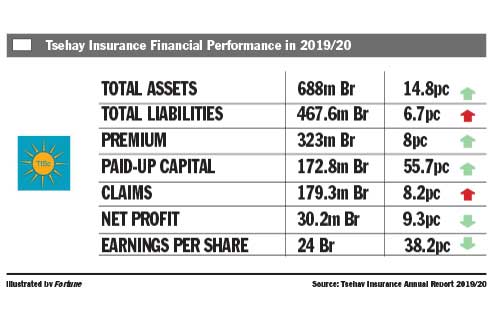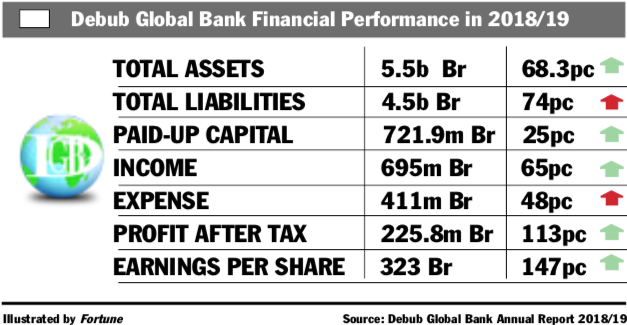
Radar | Dec 10,2022
Feb 9 , 2019
By FASIKA TADESSE ( FORTUNE STAFF WRITER )
Despite considerable improvement in its after-tax profits last fiscal year, Abay Insurance recorded a slowdown in profit growth that fell by half from the previous financial year.
The firm’s after-tax profit increased by 14pc to 66.11 million Br, lower than last year’s growth rate of 28pc. At the same time, the insurer’s earnings per share decreased by 25pc to 10,300 Br a share.
Two years ago, Abay paid 12,877 Br as dividends, reversing a downward spiral between 2014 and 2016 caused by a capitalisation drive. However, the spiralling decline in shareholder earnings re-emerged last fiscal year.
The decline must have been due to increases in paid-up capital, according to Abdulmenan Mohammed, a financial statement analyst with deep experience in the finance and audit industries.
Abay increased its paid-up capital by 27pc to 179.7 million Br and managed to register a positive performance in after-tax profit performance.
The positive performance was earned after undergoing multiple challenges, according to Mitiku Beyene, board chairperson of the insurer.
“Deterioration of professional practices and unhealthy competition confined to reductions of premium rates were the major threats the insurance industry faced,” remarked Mitiku in the firm’s annual report.
Out of the 17 insurance firms, one-third of the market is controlled by the state-owned Ethiopian Insurance Company (EIC).
Abay’s profit rose as a result of increased underwritings and investment income.
Abay gained 222.41 million Birr in underwritings, showing an increase of 14pc.
It also netted 4.3 million Br from the new insurance policy it introduced two years ago, Life Fund, which returned a 127pc increase from the previous year.
Last year, the insurance industry registered 8.6 billion Br in underwritings, a 14.7pc increase. Abay accounts for 2.6pc of the total underwritings registered by the industry at large.
Abay ceded 59.12 million Br to reinsurers, leading to the firm’s retention rate of 73pc, slightly below the industry average of 78pc.
“Abay needs to consider increasing the retention rate,” said Abdulmenan.
The retention rate has slightly increased in the reported year, according to Behailu Betseha, the finance and investment manager of Abay.
“Compared to the previous years where we ceded higher amounts to reinsurers,” said Behailu, “we did well last year by increasing the retention rate by a percentage point.”
Abay paid out 89.97 million Br in claims, a 13pc increase. The growth is considered reasonable in line with the growth in underwriting.
The company was strategic in covering risks, so that the loss ratio of the firm was better, according to Behailu. “Our underwriting prudence was good,” he said.
Established in 2010 with 12 shareholders, Abay Insurance recorded a positive outcome in investment activities. Income from interest, savings and dividends from equity investments increased by 15pc to 37.83 million Br.
Both income and expenses have increased in tandem at the insurer.
Salaries and benefits paid to its 173 employees went up by 18pc to 26.45 million Br, and other operating expenses also increased by 16pc to 20.25 million Br.
The rise in salaries and benefits and other operating expenses at Abay is much lower than the preceding year. In the previous year, Abay’s expense in salaries and benefits rose by 52pc.
The total assets of Abay increased by 24pc to 628 million Br, of which 329.2 million Br was held in savings and 52.28 million Br in investments.
These investments account for 60.7pc of total assets at Abay. This ratio dropped from the preceding year’s 69.5pc as a result of an improved liquidity level. Liquidity analysis shows that the level at Abay has increased considerably.
Its cash and bank balances soared by 113pc to 36.63 million Br, and the ratio of cash and bank balances to total assets increased to 5.8pc from 3.4pc.
“Abay did very well in improving its liquidity level,” said Abdulmenan.
The capital and none distributable reserves at Abay accounted for 32.6pc of its total assets.
“As Abay is a well-capitalised insurance company, it should use its strong capital base to increase its shareholder returns,” suggests Abdulmenan.
PUBLISHED ON
Feb 09,2019 [ VOL
19 , NO
980]

Radar | Dec 10,2022

Fortune News | Oct 20,2024

Radar | Apr 09,2022

Commentaries | Aug 03,2024

Radar | Jun 01,2019

Radar | May 13,2023

Fortune News | Feb 13,2021

Fortune News | Jan 25,2020

Fortune News | Feb 29,2020

Fortune News | Oct 14,2023

Dec 22 , 2024 . By TIZITA SHEWAFERAW
Charged with transforming colossal state-owned enterprises into modern and competitiv...

Aug 18 , 2024 . By AKSAH ITALO
Although predictable Yonas Zerihun's job in the ride-hailing service is not immune to...

Jul 28 , 2024 . By TIZITA SHEWAFERAW
Unhabitual, perhaps too many, Samuel Gebreyohannes, 38, used to occasionally enjoy a couple of beers at breakfast. However, he recently swit...

Jul 13 , 2024 . By AKSAH ITALO
Investors who rely on tractors, trucks, and field vehicles for commuting, transporting commodities, and f...

Jul 5 , 2025
Six years ago, Ethiopia was the darling of international liberal commentators. A year...

Jun 28 , 2025
Meseret Damtie, the assertive auditor general, has never been shy about naming names...

Jun 21 , 2025
A well-worn adage says, “Budget is not destiny, but it is direction.” Examining t...

Jun 14 , 2025
Yet again, the Horn of Africa is bracing for trouble. A region already frayed by wars...